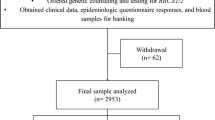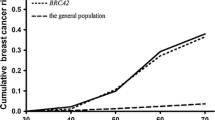Abstract
BReast CAncer genes 1 and 2 (BRCA1 and BRCA2) mutation carriers diagnosed with breast cancer are at increased risk of developing a second primary breast cancer. Data from high-risk clinics may be subject to different biases which can cause both over and underestimation of this risk. Using data from a large multi-institutional family registry we estimated the 10-year cumulative risk of second primary breast cancer including more complete testing information on family members. We prospectively followed 800 women diagnosed with breast cancer from the Breast Cancer Family Registry (BCFR) who were carriers of a BRCA1 or BRCA2 pathogenic mutation or a variant of unknown clinical significance. In order to limit survival and ascertainment bias, cases were limited to those diagnosed with a first primary breast cancer from 1994 to 2001 and enrolled in the BCFR within 3 years after their cancer diagnosis. We excluded women enrolled after being diagnosed with a second breast cancer. We calculated 10-year incidence of second primary breast cancers. The 10-year incidence of a second primary breast cancer was highest in BRCA1 mutation carriers (17 %; 95 % CI 11–25 %), with even higher estimates in those first diagnosed under the age of 40 (21 %; 95 % CI 13–34 %). Lower rates were found in BRCA2 mutation carriers (7 %; 95 % CI 3–15 %) and women with a variant of unknown clinical significance (6 %; 95 % CI 4–9 %). Whereas the cumulative 10-year incidence of second primary breast cancer is high in BRCA1 mutation carriers, the estimates in BRCA2 mutation carriers and women with variants of unknown clinical significance are similar to those reported in women with sporadic breast cancer.

Similar content being viewed by others
References
Smith KL, Isaacs C (2011) BRCA mutation testing in determining breast cancer treatment. Cancer J 17(6):492–499
Metcalfe K, Lynch HT, Ghadirian P et al (2004) Contralateral breast cancer in BRCA1 and BRCA2 mutation carriers. J Clin Oncol 22(12):2328–2335
Malone KE, Begg CB, Haile RW et al (2010) Population-based study of the risk of second primary contralateral breast cancer associated with carrying a mutation in BRCA1 or BRCA2. J Clin Oncol 28(14):2404–2410
Graeser MK, Engel C, Rhiem K et al (2009) Contralateral breast cancer risk in BRCA1 and BRCA2 mutation carriers. J Clin Oncol 27(35):5887–5892
Pierce LJ, Phillips KA, Griffith KA et al (2010) Local therapy in BRCA1 and BRCA2 mutation carriers with operable breast cancer: comparison of breast conservation and mastectomy. Breast Cancer Res Treat 121(2):389–398
Brekelmans CT, Tilanus-Linthorst MM, Seynaeve C et al (2007) Tumour characteristics, survival and prognostic factors of hereditary breast cancer from BRCA2-, BRCA1- and non-BRCA1/2 families as compared to sporadic breast cancer cases. Eur J Cancer 43(5):867–876
Lostumbo L, Carbine NE, Wallace J (2010) Prophylactic mastectomy for the prevention of breast cancer. Cochrane Database Syst Rev. doi:10.1002/14651858.CD002748.pub3
Lee J, Lee SK, Kim S et al (2011) Does immediate breast reconstruction after mastectomy affect the initiation of adjuvant chemotherapy? J Breast Cancer 14(4):322–327
Hamahata A, Kubo K, Takei H et al (2015) Impact of immediate breast reconstruction on postoperative adjuvant chemotherapy: a single center study. Breast Cancer 22(3):287–291
Yu KD, Huang S, Zhang JX, Liu GY, Shao ZM (2013) Association between delayed initiation of adjuvant CMF or anthracycline-based chemotherapy and survival in breast cancer: a systematic review and meta-analysis. BMC Cancer 13:240
John EM, Hopper JL, Beck JC, Breast Cancer Family Registry et al (2006) The Breast Cancer Family Registry: an infrastructure for cooperative multinational, interdisciplinary and translational studies of the genetic epidemiology of breast cancer. Breast Cancer Res 6(4):R375–R389
Neuhausen SL, Ozcelik H, Southey MC, Breast Cancer Family Registry et al (2009) BRCA1 and BRCA2 mutation carriers in the Breast Cancer Family Registry: an open resource for collaborative research. Breast Cancer Res Treat 116(2):379–386
Smith LD, Tesoriero AA, Wong EM et al (2011) Contribution of large genomic BRCA1 alterations to early-onset breast cancer selected for family history and tumour morphology: a report from the Breast Cancer Family Registry. Breast Cancer Res 13(1):R14
Vallée MP, Francy TC, Judkins MK, Babikyan D, Lesueur F, Gammon A, Goldgar DE, Couch FJ, Tavtigian SV (2012) Classification of missense substitutions in the BRCA genes: a database dedicated to Ex-UVs. Hum Mutat 33(1):22–28
Reding KW, Bernstein JL, Langholz BM, WECARE Collaborative Study Group et al (2010) Adjuvant systemic therapy for breast cancer in BRCA1/BRCA2 mutation carriers in a population-based study of risk of contralateral breast cancer. Breast Cancer Res Treat 123(2):491–498
Gao X, Fisher SG, Emami B (2003) Risk of second primary cancer in the contralateral breast in women treated for early-stage breast cancer: a population-based study. Int J Radiat Oncol Biol Phys 56(4):1038–1045
Klaren HM, van’t Veer LJ, van Leeuwen FE, Rookus MA (2003) Potential for bias in studies on efficacy of prophylactic surgery for BRCA1 and BRCA2 mutation. J Natl Cancer Inst 95(13):941–947
Tilanus-Linthorst MM, Bartels KC, Alves C et al (2006) Selection bias influences reported contralateral breast cancer incidence and survival in high risk non-BRCA1/2 patients. Breast Cancer Res Treat 95(2):117–123
van Sprundel TC, Schmidt MK, Rookus MA et al (2005) Risk reduction of contralateral breast cancer and survival after contralateral prophylactic mastectomy in BRCA1 or BRCA2 mutation carriers. Br J Cancer 93(3):287–292
Metcalfe K, Gershman S, Lynch HT et al (2011) Predictors of contralateral breast cancer in BRCA1 and BRCA2 mutation carriers. Br J Cancer 104(9):1384–1392
Gronwald J, Tung N, Foulkes WD, Hereditary Breast Cancer Clinical Study Group et al (2006) Tamoxifen and contralateral breast cancer in BRCA1 and BRCA2 carriers: an update. Int J Cancer 118(9):2281–2284
Phillips KA, Milne RL, Rookus MA et al (2013) Tamoxifen and risk of contralateral breast cancer for BRCA1 and BRCA2 mutation carriers. J Clin Oncol 31(25):3091–3099
Figueiredo JC, Brooks JD, Conti DV et al (2011) Risk of contralateral breast cancer associated with common variants in BRCA1 and BRCA2: potential modifying effect of BRCA1/BRCA2 mutation carrier status. Breast Cancer Res Treat 127(3):819–829
Shahedi K, Emanuelsson M, Wiklund F, Gronberg H (2006) High risk of contralateral breast carcinoma in women with hereditary/familial non-BRCA1/BRCA2 breast carcinoma. Cancer 106(6):1237–1242
Acknowledgments
This work was supported by grant UM1 CA164920 from the USA National Cancer Institute. The content of this manuscript does not necessarily reflect the views or policies of the National Cancer Institute or any of the collaborating centers in the Breast Cancer Family Registry (BCFR), nor does mention of trade names, commercial products, or organizations imply endorsement by the USA Government or the BCFR.
Conflict of interest
Dr. Chung has stock ownership and consulting role in Bioreference Laboratories.
Author information
Authors and Affiliations
Corresponding author
Rights and permissions
About this article
Cite this article
Menes, T.S., Terry, M.B., Goldgar, D. et al. Second primary breast cancer in BRCA1 and BRCA2 mutation carriers: 10-year cumulative incidence in the Breast Cancer Family Registry. Breast Cancer Res Treat 151, 653–660 (2015). https://doi.org/10.1007/s10549-015-3419-y
Received:
Accepted:
Published:
Issue Date:
DOI: https://doi.org/10.1007/s10549-015-3419-y




